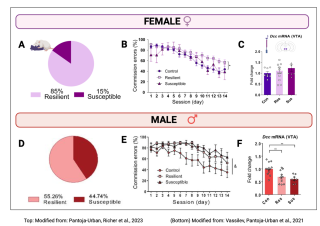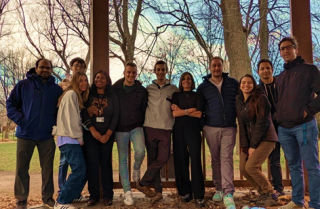Samuel Richer on Gains and Losses: Resilience to Social Defeat Stress in Adolescent Female Mice

Recently, on a cold and snowy January day, while taking the metro to work, my friend took me by surprise and out of the blue, asked me why I decided to become a neuroscientist. “All those years of schooling, trying to figure out pathways, equations, mechanisms… Why would you go into such a difficult field!” After taking a minute to think, the metro doors closed, and I answered very simply “Because science is about the stories that people live with everyday”
A story common to us all is our growth and most interesting to me as a neuroscientist is the growth of our brain. Renowned for its complexity, the brain is a fascinating organ undergoing tightly orchestrated development through adolescence. I always wondered how this convoluted development shapes who we are, and the person we become. Behind this captivating scientific question lies real people, their stories, and their lived experiences.
My story takes place in the beautiful Laurentian mountains where I was born and raised with my loving family. Growing up, my backyard was my laboratory and Mother Nature was my teacher. From a young age, I developed a deep respect for her and cherished the beauty in her creations. I was analyzing rocks, captivated by the sway of trees, and watching caterpillars morph into butterflies: science was in my blood. I found a true passion for learning and was the first in my family to move out to Montréal at 17 years old to study science in CEGEP. Growing up also meant facing adversity and navigating difficult environments. Adolescence can be a stressful time where some experience bullying, academic stress, peer pressure, substance abuse and most common to all, trying to fit in. Despite facing personal challenges during my undergraduate years, including navigating my sexual identity, and battling the dark depths of depression, I was lucky enough to have my amazing family and friends who allowed me to re-emerge stronger. With many around me who struggled with anxiety and my mom who battled severe depression following her breast cancer diagnosis, I was frustrated and wanted to help others facing mental health struggles.
I started my master’s degree in the Flores lab at McGill University, and delved into how stress affects the brain during the crucial adolescent years and how it alters mental health trajectories. Working alongside the brilliant and dedicated scientist, Dr. Andrea Pantoja-Urban, and under the constant stream of scientific curiosity of my supervisor Dr. Cecilia Flores, we made strides in advancing the field of social stress. Mental health and its ramifications are to be taken seriously, especially during adolescence, a time of immense social stress, where every experience feels amplified, and the stakes are sky-high. Unfortunately, while we're grappling with these social stressors, our brains are still in the oven, baking away at their development. The impact of experiences can be profound, shaping the trajectory of our mental health for years to come and echoing through our lives like ripples in a pond.
Through our research, we gained insight into how such adverse experiences can impact rodent brain circuitry and behavior throughout development. Despite the wealth of knowledge gathered from studies using animal models, there's been a glaring oversight—a gap in research that's hard to ignore. The female sex has long been neglected in these studies, leaving the stories of half of the population underrepresented in our quest to understand psychiatric disorders. It's a revelation that struck a chord with us. How could we hope to fully grasp the complexities of mental health when a significant portion of the puzzle was omitted? Fueled by our passion for equality and scientific progress, we joined the chorus of voices calling for these unanswered questions.
In the dynamic realm of neuroscience, every publication represents a milestone—a testament to the relentless pursuit of knowledge and understanding. Among these, our recent publication in Biological Psychiatry entitled: "Gains and Losses: Resilience to Social Defeat Stress in Adolescent Female Mice," stands as a beacon of progress and inclusivity in research (See Publication here: https://www.sciencedirect.com/science/article/pii/S0006322323013689).
At the heart of this work lies an exploration of adolescent social adversity and its intricate effects on neurodevelopment and behavior. Since adolescence in mice is a short period of life encompassing many discreet temporal windows of vulnerability, we needed a model capable of capturing these distinct chronological windows of susceptibility. Through lots of trouble shooting and hard work, we were able to develop a novel paradigm that is short but robust enough to induce social stress during specific periods of rodent adolescence. It also allowed us to segregate mice based on whether the stress experience induced social avoidance toward another mouse (susceptible) or not (resilient) based on a social interaction task. Importantly, this is the only model available to study social defeat stress in adolescent C57BL/6 female mice.
We found that when female mice underwent social stress in early adolescence, the majority displayed remarkable “resilience” against stress-induced social avoidance (Figure 1A). However, this so called “resilience” against stress outcomes during adolescence did not protect against harmful consequences in other behavioral domains. As adolescent female mice transitioned into adulthood, a surprising twist unfolded: those females which did not show social impairment in adolescence (so called “resilient” females) developed deficits in impulse control in adulthood (Figure 1B). Poor inhibitory control is an endophenotype which often characterizes risk for psychiatric disorders. Our previous social defeat studies in adolescent males showed instead a higher proportion of social avoidance (susceptibility) to stress (Figure 1D) and all stressed males displayed cognitive deficits in adulthood (Figure 1E).

While behavior teaches us a lot about the effects of stress, in this study we also assessed the potential underlying molecular mechanisms. We therefore investigated alterations in guidance cue systems controlling dopamine maturation in adolescence. We addressed this by assessing changes in levels of the DCC guidance cue receptor, which orchestrates proper prefrontal cortex dopamine maturation in adolescence. We found that compared to their control counterparts, adult females exposed to social defeat stress in adolescence showed no changes in Dcc mRNA expression in cell body regions of dopamine neurons (Figure 1C). In contrast, we previously showed that social defeat stress reduces Dcc mRNA expression in adolescent males, compared to controls (Fig 1F). These findings suggest sex-specific mechanisms involved in the short and enduring impact of adolescent social stress.
In essence, our research reveals that short and long-term effects of social stress in adolescence vary according to age, behavioral domain, and sex. This work raises intriguing questions about the complex interplay between biological sex and developmental stage. In a field where gender and sex disparities persist, the significance of including both sexes cannot be overstated. By uncovering how stress shapes the developing adolescent male and female brain, we can gain valuable insights into the processes that drive risk for psychiatric disorders.
When I was young, I thought people decided to study science due to their curiosity, or their observant nature. I thought maybe it was because they liked searching for answers and discovering things. For me, science is about listening to people’s stories. It’s about taking difficult questions and trying to add a drop to the bucket of ideas that will one day help others. In my view, science relies on giving people equal opportunities for happiness and reducing suffering for everyone on this planet. I believe that our study is a good example of how a male-centric approach limits knowledge and the power of curiosity-driven science based on equity. This publication fills a gap in the field and paves the way for future investigations regarding female adolescent neurodevelopment.
